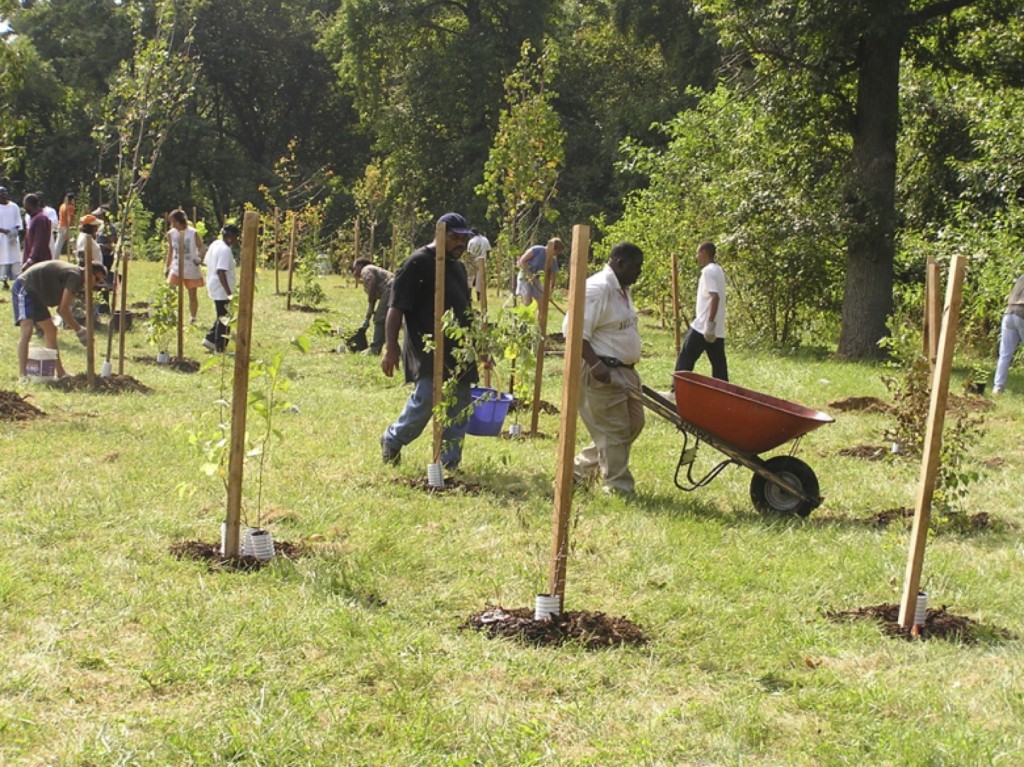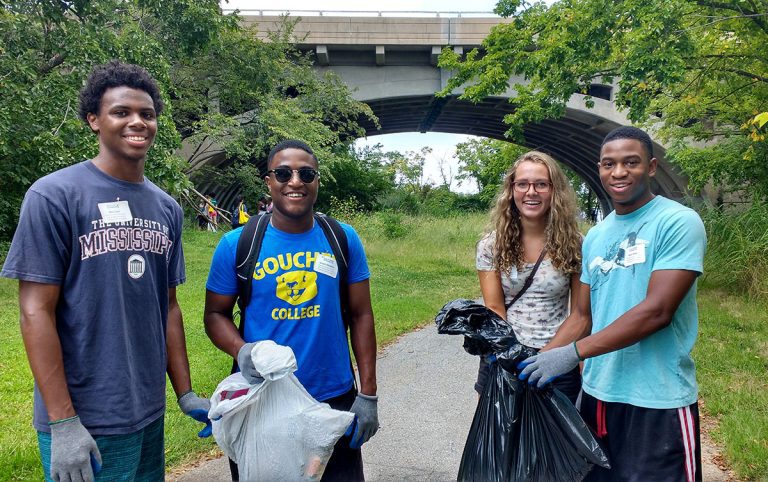A Tree Grows in Baltimore

[NOTE: Debra Lenik is the staff Volunteer Coordinator at Blue Water Baltimore, and first joined us in 2010 as part of the AmeriCorps Volunteer Maryland program.]
A colleague recently asked me where I saw myself in ten years. Holy mackerel, I thought. Ten years?! I’m 23 years old now and of course, that’s as far away from 33 as it is from 13. Literally speaking, in any case. I don’t have a clue where I might be in ten years—or at least, that was my primary reaction.
I’m going to switch gears on you here a little bit, but stick with me. Last Wednesday, Darin and I were en route back to the office from a meeting when he asked if we could take a quick detour. He elaborated, “I just want to check on a few old tree planting projects. It’ll only take fifteen minutes.” Well, I knew it wouldn’t take fifteen minutes just to drive there, which probably meant that there was maintenance work to be done on site—and that foretold a minimum of half an hour’s work. But if I didn’t count the mapping project waiting patiently at my desk, I didn’t have any commitments that afternoon. “Sure thing,” I said. So he drove the Hippie-Mobile, our aging, patchouli-infused Ford Taurus, and parked on the street along Moore’s Run Park. We got out and began walking towards our tree planting site. But where were the saplings that our volunteers had allegedly planted?

Oh, my goodness. My jaw dropped as Darin knelt to remove an old mower guard…from near the base of a black locust tree that was more than 30 feet tall. I’m not stupid; I know that trees grow. But it’s one thing to spend several months each fall and spring patiently teaching middle school students to rake out roots and to mulch in the shape of a doughnut. And it’s another thing entirely to see a tree that was planted in 2004 fulfilling the wildest dreams of every urban forester. At Moore’s Run Park, there are river birches, redbuds, and red maples. There are sweet gums and lindens and oaks. Admittedly, some of them have had their bark damaged by careless mowers, but for the most part, they have flourished. A group of committed volunteers stubbornly planted and maintained them despite the long odds against urban trees. Those trees have now grown too strong for a vandal to break in half. They are restoring the riparian buffer and absorbing stormwater that would otherwise run off the compacted lawns directly into the stream. And they have absolutely, vitally confirmed my belief in the work that I am doing.
It is the job of a Volunteer Coordinator to be a perpetual optimist. I am responsible for recruiting volunteers, and for keeping them engaged, by reaching out and convincing and affirming and re-affirming to them that the energy they give to Blue Water Baltimore is crucial to the health of our streams and to that of our communities. And it is—I could never have planted 2,115 trees by myself last year, and I could not keep those trees watered and mulched and properly pruned even if I did nothing else all day long. But seeing that gorgeous, mature tree canopy made me realize that I hadn’t truly been speaking to volunteers out of the depth of my own conviction. Sure, I knew that trees were a good investment in the future of Baltimore City. And yeah, I could feel that the air was cooler within the heavily forested parks that are Baltimore’s urban oases. But before last Wednesday, I had not honestly recognized the potential of each plant: that they would one day join the vanguard in protecting and restoring the region’s streams.

I’m at a stage in my life where very little that I do feels permanent. Sometimes it seems like it’ll always be that way, since creating substantive change can be an agonizingly slow process—especially when you’re talking about the landscape of a city or the mindset of its people. Here’s the thing, though: there’s never a better time to plant a tree than right now. The sooner you do it, the sooner you and your children and your children’s children can enjoy cooler and cleaner air, healthier streams, and a safer community. I hope that you’ll consider joining us at one of our cleaning and greening projects this spring to start building your legacy in Baltimore. Give it a shot and I think you’ll feel pretty good about the impact that three hours—or more—can have. You can look at our calendar to see what Blue Water Baltimore has going on, or you can email me to find out what projects best fit your interests and abilities. I can even help you plan a service project of your own with your school, church, or company.
So the next time someone asks me what I see myself doing in ten years, I probably still won’t know what career I’ll have, or if I’ll have a family, or even what city I’ll be living in. But I do know that ten years from now, I will be certain to visit the dozens of project sites where Blue Water Baltimore has planted during my time as Volunteer Coordinator, and I will happily tell anyone who listens that I helped to plant those beautiful trees.

